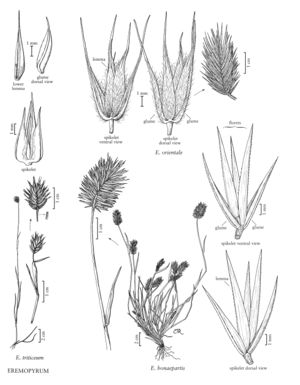Eremopyrum orientale
Culms to 15 cm, smooth, mostly glabrous, puberulent below the spikes. Sheaths of upper leaves often somewhat inflated; blades 2-3 mm wide, more or less scabrous on both surfaces. Spikes 1.3-3.5 cm long, 0.9-1.8 cm wide, usually ovate-elliptic; disarticulation at the rachis nodes. Spikelets 7-12 mm long, with 2-3 florets. Glumes 5-12 mm, lanceolate, 3-5-veined, 1-keeled, lateral 2-3 veins prominent, hispid, bases curved, apices gradually tapering to a 0.5-3 mm awn; lemmas 5-12 mm, hispid, hairs 0.5-2 mm, prominently keeled, awned, awns 0.5-4 mm; paleas pubescent between the keels, keels prolonged into 2 toothlike appendages. 2n = 28.
Distribution
N.Y., B.C., Man.
Discussion
Eremopyrum orientale has been collected from southern Manitoba, growing with E. triticeum, and has been reported from southeastern British Columbia and New York. It is not known to be established in the Flora region.
Selected References
None.
Lower Taxa
"decumbent" is not a number.
